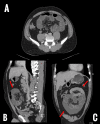Congenital Peritoneal Encapsulation: A Literature Review of a Rare Pathology
- PMID: 36569734
- PMCID: PMC9772582
- DOI: 10.7759/cureus.31765
Congenital Peritoneal Encapsulation: A Literature Review of a Rare Pathology
Abstract
Congenital peritoneal encapsulation (CPE) is a rare, congenital entity in which an accessory peritoneal membrane surrounds the small bowel. This condition is usually asymptomatic and rarely causes intestinal obstruction. Despite the rare cause of intestinal obstruction, it has excellent post-operative recovery. There is no gold standard approach for investigating CPE; however, a computerized tomography scan of the abdomen might be helpful. Furthermore, diagnostic laparoscopy could be considered an adjunct. This report highlights the rare congenital anomaly as a cause of intestinal obstruction.
Keywords: abdominal cocoon; congenital peritoneal encapsulation; rare congenital anomaly; small intestinal obstruction; surgery.
Copyright © 2022, Chowdhury et al.
Conflict of interest statement
The authors have declared that no competing interests exist.
Figures



References
-
- On an abnormal arrangement of the peritoneum, with remarks on the development of the mesocolon. Cleland Cleland. https://www.ncbi.nlm.nih.gov/pmc/articles/PMC1318602/pdf/janatphys00216-... J Anat Physiol. 1868;2:201–206. - PMC - PubMed
-
- Peritoneal encapsulation - a rare cause of small bowel obstruction. Toma EA, Giulea C, Enciu O, Calu V, Miron A. Chirurgia (Bucur) 2019;114:290–294. - PubMed
Publication types
LinkOut - more resources
Full Text Sources
Molecular Biology Databases
Research Materials
Miscellaneous
